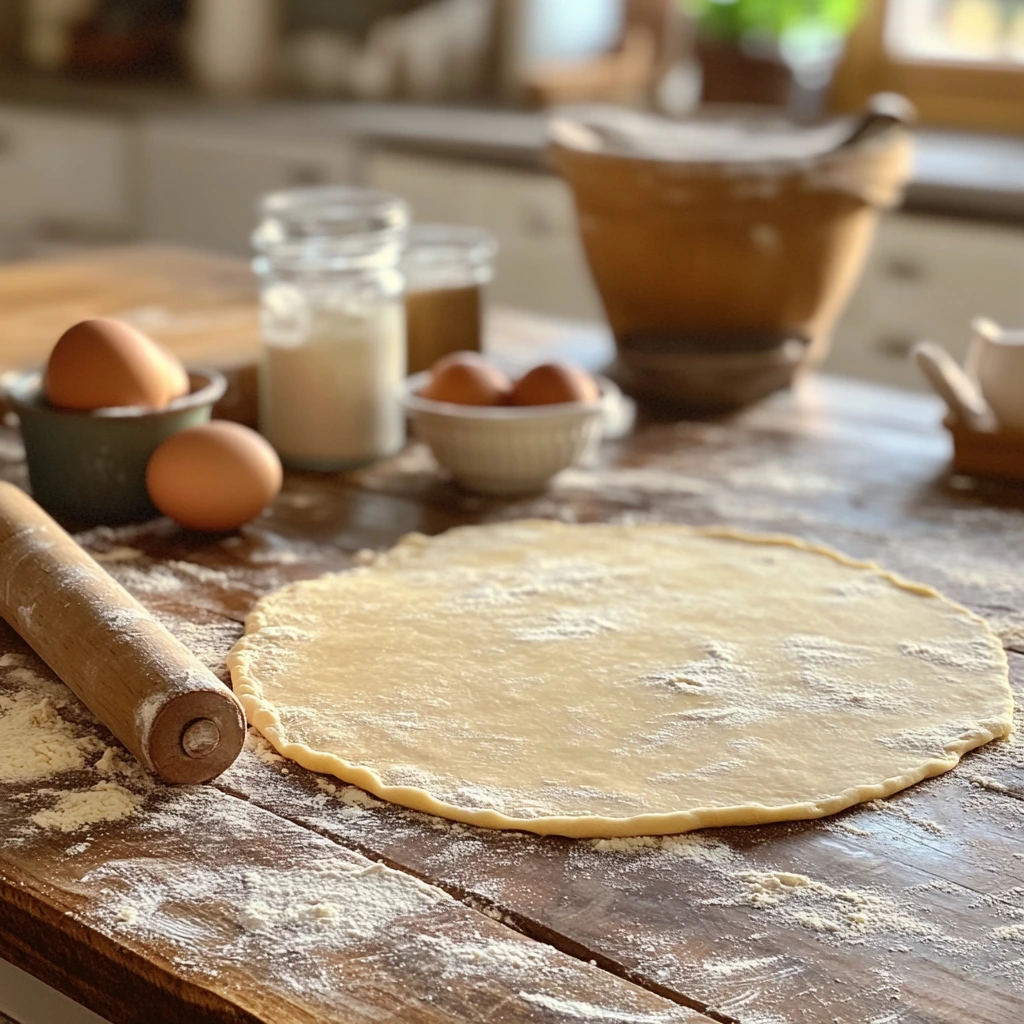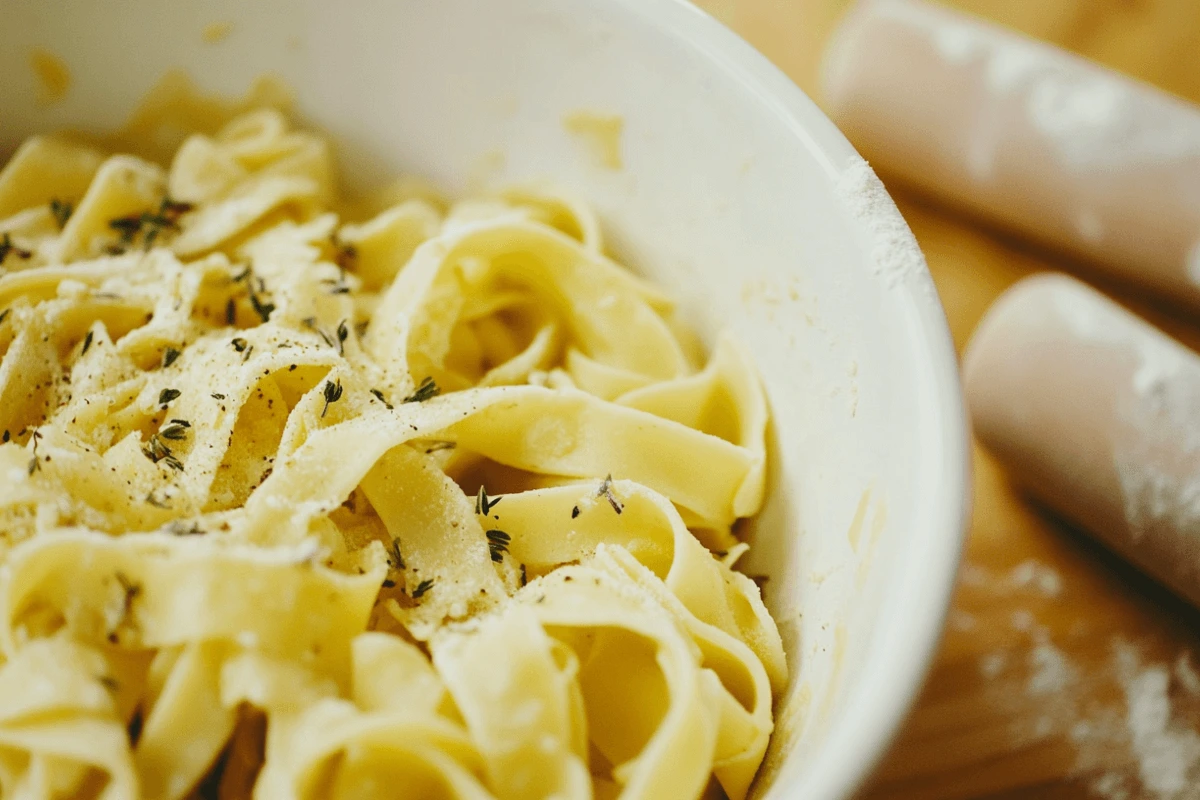Introduction to Gluten-Free Egg Noodles
What’s the Deal with Gluten-Free Diets?
If you’re following a gluten-free pasta, you already know it’s not just a trend—it’s a lifestyle. Whether you’ve got celiac disease, gluten sensitivity, or just want to avoid gluten for personal reasons, finding satisfying food alternatives can feel like a chore. And let’s be real, pasta is one of the hardest things to give up.
That’s where gluten-free egg noodles come in. They’re a fantastic alternative to regular noodles, letting you enjoy your favorite pasta dishes without compromising on taste or texture.
What Are Gluten-Free Egg Noodles?
Okay, so what exactly are gluten-free egg noodles? They’re pasta made with gluten-free flours (like rice or tapioca), eggs, and a few other simple ingredients. These noodles are soft, tender, and versatile, meaning they can work in everything from soups to stir-fries. Unlike some store-bought gluten-free pastas that can feel gritty or fall apart when cooked, homemade egg noodles hold their own—literally.
Why You’ll Love This Recipe
This recipe is all about making gluten-free egg noodles that are simple, tasty, and approachable. You don’t need a ton of fancy equipment or hard-to-find ingredients. Plus, the process is kind of fun—it’s like playing with edible Play-Doh (but better, obviously).
Whether you’re planning a comforting chicken noodle soup, a classic pasta dish, or something completely unique, these noodles will be your new go-to. Trust me, your taste buds—and your dinner guests—will thank you.
Table of contents
Ingredients and Equipment for Gluten-Free Egg Noodles recipe
Essential Ingredients
Making gluten-free egg noodles doesn’t require a long shopping list, but the right ingredients are key to getting that perfect texture and taste. Here’s what you’ll need:
- Gluten-Free Flour Blend: A good flour blend is the backbone of your noodles. Look for one that combines rice flour, tapioca starch, and potato starch. These ingredients mimic the elasticity of wheat flour without the gluten.
- Xanthan Gum: This is your secret weapon. Xanthan gum acts like glue, holding the dough together and keeping it from crumbling. It’s a must-have for gluten-free baking.
- Eggs and Egg Yolks: These provide richness, color, and structure to your noodles. The extra yolks add a velvety texture that’s hard to beat.
- Optional Additions: A splash of olive oil can make the dough easier to work with, and a pinch of salt enhances the flavor.
Recommended Gluten-Free Flour Blends
Not all gluten-free flour blends are created equal. Here are a few popular ones that work well for pasta:
- Bob’s Red Mill 1-to-1 Baking Flour: This one’s a favorite for its balanced mix of flours and starches.
- King Arthur Gluten-Free Multi-Purpose Flour: Known for its versatility, this blend delivers a smooth dough and great flavor.
- Cup4Cup Multipurpose Flour: It’s pricier, but the texture is top-notch for pasta-making.
If you’re feeling adventurous, you can make your own blend with equal parts rice flour, tapioca starch, and potato starch.
Try this comforting White Turkey Chili alongside a smoky bowl of Chipotle Ground Beef Soup for a hearty meal.
Equipment Needed
Before you get started, make sure your kitchen is stocked with these tools:
- Food Processor: While you can mix by hand, a food processor speeds up the process and ensures an even dough.
- Rolling Pin: Essential for rolling out the dough to your desired thickness.
- Sharp Knife or Pizza Cutter: Perfect for slicing the dough into noodle shapes.
- Pasta Machine (Optional): If you’re serious about pasta, a pasta machine makes it easier to roll and cut your noodles evenly. But don’t worry—your hands and a rolling pin work just fine.
- Clean Counter or Baking Mat: You’ll need plenty of space to roll out the dough.
Pro Tips for Success
- Keep a small bowl of extra gluten-free flour handy to dust your surface while rolling. It prevents sticking without making the dough too dry.
- If the dough feels too dry, add a teaspoon of water or olive oil at a time. On the flip side, if it’s sticky, sprinkle in a little more flour.
- Invest in a kitchen scale if you don’t already have one. Precision is especially important in gluten-free recipes.
With your ingredients and tools ready, you’re fully prepared to tackle the fun part: making the noodles! First, we’ll mix the dough, then move on to rolling it out, and finally, we’ll cut it into perfect shapes. Step by step, you’ll see how simple this process can be. So, grab your rolling pin, sprinkle some flour, and let’s get rolling—literally—in the next section.
Step-by-Step Recipe for Gluten-Free Egg Noodles
Preparation Steps
Making gluten-free egg noodles might sound intimidating, but trust me—it’s easier than you think. Follow these simple steps, and you’ll have homemade pasta in no time.
- Combine Dry Ingredients: In a large mixing bowl or food processor, mix 2 cups of gluten-free flour blend with 1 teaspoon of xanthan gum and a pinch of salt. This dry base will give your dough structure.
- Add Wet Ingredients: Crack 2 whole eggs and 2 egg yolks into the bowl. If you’re using a food processor, pulse until the dough comes together. If mixing by hand, stir until it’s crumbly, then knead it into a ball.
- Adjust the Dough: If the dough feels too dry, add water or olive oil, a teaspoon at a time. If it’s too sticky, sprinkle in a little more flour. The dough should be soft but not tacky.
- Rest the Dough: Wrap the dough in plastic wrap and let it rest at room temperature for 30 minutes. This gives the xanthan gum time to work its magic, making the dough easier to roll.
Rolling and Cutting the Noodles
- Prepare Your Workspace: Lightly flour your countertop or a baking mat with gluten-free flour to prevent sticking.
- Roll Out the Dough: Divide the dough into two pieces to make it easier to handle. Using a rolling pin, roll each piece to about 1/8 inch thick. If you’re using a pasta machine, start on the widest setting and gradually roll to your desired thickness.
- Cut the Noodles: Use a sharp knife, pizza cutter, or pasta cutter to slice the dough into your preferred shape. For fettuccine, aim for strips about 1/4 inch wide. For egg noodle soup, cut thinner strips.
- Dust and Separate: Toss the cut noodles lightly in flour to prevent them from sticking together. Lay them out in a single layer on a floured baking sheet or kitchen towel.

Cooking Instructions
- Boil Water: Fill a large pot with water, add a generous pinch of salt, and bring it to a rolling boil.
- Cook the Noodles: Drop the noodles into the boiling water. Fresh gluten-free noodles cook quickly—2 to 4 minutes is usually enough. Stir gently to prevent sticking.
- Drain and Serve: Once the noodles are tender, drain them in a colander and rinse lightly with warm water. Toss them with your favorite sauce, broth, or a simple drizzle of olive oil.
Pro Tips for Perfect Gluten-Free Noodles
- Don’t Overcook: Fresh noodles cook faster than store-bought, so watch them closely to avoid mushiness.
- Make Extra: These noodles freeze well! Lay them flat on a baking sheet, freeze until firm, then store in a zip-top bag for up to a month.
- Flavor Boost: Add a pinch of garlic powder, onion powder, or Italian herbs to the dough for an extra pop of flavor.
With your noodles cooked to perfection, it’s time to think about how to serve them! Let’s get into variations and serving suggestions in the next section.
Variations and Serving Suggestions
Different Types of Gluten-Free Egg Noodles
Gluten-free egg noodles are super versatile, and you can tweak the recipe to match your cravings or dietary needs. Here are some fun variations to try:
- Buckwheat Noodles: Replace part of the gluten-free flour blend with buckwheat flour for a nutty, earthy flavor. These are perfect for hearty dishes like beef stroganoff.
- Rice Flour Noodles: Using mostly rice flour creates light, delicate noodles that pair wonderfully with brothy soups.
- Chickpea Flour Noodles: Swap in chickpea flour for a protein-packed option. These noodles have a slightly nutty taste and work well in vegetarian dishes.
- Spinach Noodles: Blend a handful of cooked, pureed spinach into the dough for vibrant green noodles. Plus, hello, extra nutrients!
- Herbed Noodles: Add a teaspoon of dried basil, oregano, or parsley to the dough for an herby twist.
Serving Ideas for Gluten-Free Egg Noodles
Homemade gluten-free egg noodles are a blank canvas for your favorite dishes. Here’s some inspiration to get you started:
- Classic Chicken Noodle Soup
These noodles were born to swim in a warm, comforting bowl of chicken soup. Toss them in at the end of cooking for a hearty meal. - Creamy Alfredo
Toss the noodles with a rich Alfredo sauce, a sprinkle of Parmesan, and a pinch of black pepper. Add some grilled chicken or sautéed veggies for a complete dinner. - Vegetable Stir-Fry
Stir-fry the noodles with your favorite veggies, soy sauce, and a dash of sesame oil for a quick, healthy meal. - Pasta Salad
Let the cooked noodles cool, then toss them with olive oil, cherry tomatoes, cucumbers, and fresh herbs for a refreshing gluten-free pasta salad. - Beef Stroganoff
Serve the noodles with a creamy mushroom and beef sauce. The sturdy texture of these noodles holds up beautifully in rich, saucy dishes.
Pro Tips for Pairing Noodles with Dishes
- Lighter Dishes: Use thinner noodles for soups and broths. They cook quickly and soak up the flavors.
- Heavier Sauces: Opt for thicker noodles when serving with cream-based or meat-heavy sauces. They’ll hold their shape and won’t get lost in the mix.
- Creative Toppings: Fresh basil, a squeeze of lemon juice, or a sprinkle of chili flakes can take your dish to the next level.
If you love chili, don’t miss this creamy White Turkey Chili and its spicier counterpart, Chipotle Ground Beef Soup.
With so many options, you’ll never get bored with gluten-free egg noodles. Next, let’s tackle some frequently asked questions to make sure you’re set for success!
FAQs About Gluten-Free Egg Noodles
1. Are any egg noodles gluten-free?
Yes, but not all egg noodles are gluten-free. Traditional egg noodles are made with wheat flour, which contains gluten. However, gluten-free egg noodles are available in stores and can be made at home using gluten-free flour blends. These are perfect for people with celiac disease or gluten sensitivity.
2. What is a good substitute for egg noodles?
If you’re looking for a gluten-free option, rice noodles or glass noodles are great substitutes. Zucchini noodles (zoodles) or spaghetti squash are also fantastic alternatives if you want to go grain-free. For a heartier option, gluten-free pasta or soba noodles made from 100% buckwheat flour work well too.
3. Are ramen egg noodles gluten-free?
No, traditional ramen noodles are not gluten-free, as they’re typically made with wheat flour. However, there are gluten-free ramen options made from rice, millet, or other gluten-free grains. Always check the packaging to ensure they meet your dietary needs.
4. Are any Chinese noodles gluten-free?
Yes, some Chinese noodles are naturally gluten-free. Rice noodles and mung bean glass noodles are popular gluten-free options. However, always read labels or ask about preparation methods to avoid cross-contamination, especially when dining out.
Conclusion
Making gluten-free egg noodles at home is one of those kitchen projects that feels super rewarding. Not only are they fresh and flavorful, but they’re also way more versatile than the store-bought stuff. Whether you’re whipping up a batch for a hearty soup, a creamy pasta dish, or even a quick stir-fry, these noodles are bound to become a favorite in your gluten-free cooking routine.
The best part? You’re in full control of the ingredients, so you know exactly what’s going into your meal. Plus, the process is easier than you might think—it’s all about mixing, rolling, and cutting (with a little rest time in between).
So, what are you waiting for? Roll up your sleeves, grab your favorite gluten-free flour blend, and get started. And hey, don’t forget to share your homemade noodles with friends and family—they’ll be asking for the recipe in no time. Enjoy!
Let me know if there’s anything else you’d like to adjust or expand on!

